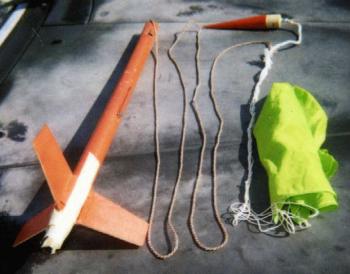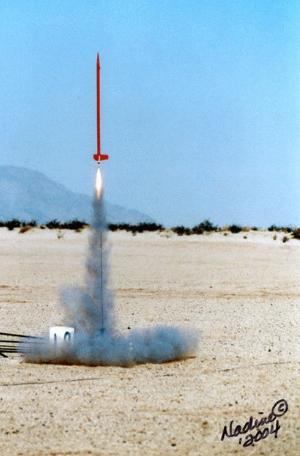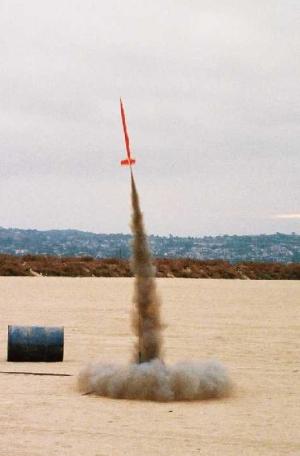Scratch CrackPipe Original Design / Scratch Built
Scratch - CrackPipe {Scratch}
Contributed by Larry Brand
| Manufacturer: | Scratch |

Brief:
CrackPipe is the fourth of my experiments in using PVC plumbing conduit for
rocket construction. It is basically similar to the "Pipecleaner" I
presented in this site earlier, but is shorter, lighter, and has very austere
3FNC construction. It is a 29mm design best flown on AT F23-7 or F20-7 motors,
or 24mm F21-8 using an adapter (all give 1400-1500'). It is light enough to fly
on an Estes 12-3 on a calm day; an F25-9 takes it to 2700'. It is extremely
tough, cheap to build ($3 less nose cone and chute), and waterproof.
Construction:
Body tube is the same grade 34mm OD PVC conduit as described for "F.I.S.H."
in this website. Components are:
1) 28" of PVC conduit from Home Depot (try for a very straight piece); can be built 12" longer if desired. Short size flies best.
2) 29mm PML solid polyurethane nose cone (needs a bit of masking tape wrap for perfect fit)
3) 3 x 1/8" Lite-Ply(tm) trapezoidal fins cut 4" high, 3" wide at bottom, 2" wide at top. 3" pieces of balsa triangle stock were used to brace the base of each fin (photo)
4) Recovery system is 6' of para cord tied to an 18" Top-Flite nylon chute in the usual way (I use roofing insulation for wadding)
5) Launch lug is 4" of 1/4" tubing (or a BIC pen body, mounted 8" above the fins -- CG is +/- 1" from the middle of launch lug (10" above fins)
5-minute epoxy was used throughout. Note that there is no motor mount or centering rings; A 29mm motor fits perfectly with two layers of top to bottom wraps of masking tape which also serves to prevent infrared thermal damage to the plastic (so don't omit). For 24mm motors, I use a LOC adapter, and masking tape as needed to give a snug twist-fit.
There is very little to describe. The cut piece of PVC used as the body tube should first be lightly sanded, then washed with soap and water, then swabbed with rubbing alcohol (I was out, so I used rotgut vodka) to remove manufacturing residuals, or glue and paint won't stick well.
The fin attachment spots are located by the "Estes method" -- 1) wrap a piece of paper around the base, and mark off the circumference, 2) divide the measured distance into thirds, 3) transfer the spacing marks to the body tube, 4) holding body tube against the corner of a door as a plumb line, draw the fin attachment positions. Fins are attached with epoxy and balsa (or scrap 1/4" spruce) braces at base.
Launch lug tube is centered 10" above the fins (this point is recommended CG).
 Recovery system is
attached by drilling a 1/8" hole 2" from top of tube, passing through
the knotted para cord, and covering the knot with half of a sliced BIC pen cap
filled with epoxy. Tie the para cord to the PML nose cone and the 18"
chute, and you are done!
Recovery system is
attached by drilling a 1/8" hole 2" from top of tube, passing through
the knotted para cord, and covering the knot with half of a sliced BIC pen cap
filled with epoxy. Tie the para cord to the PML nose cone and the 18"
chute, and you are done!
Flying weight w/o motor is 310 gms (11 oz).
I painted mine with Testors Orange spray.
Flight:
First flight was on an E30-7 using the 24mm adapter -- very fast boost to about
the 1000-1200' sims predicted.
Second flight was on an F21-8, perfect shot to about the 1700' predicted (see great launch photo by PhotosbyNadine).
Third shot, on an F25-9, went out-of-sight (sims said 2700') and separated, due to my forgetting to add wadding, causing the ejection charge to blast the shock cord in half. Body tube came in ballistic, and splintered the top few inches of PVC. So I cut it down from 40" to 28", reattached the recovery system, and resumed flying.
The best motor for the rocket is the F23-7 (or similar F20-7) Econojet, and I have started using this combination (see photo) at every launch to test the wind before flying bigger things. Important to wrap the motor top to bottom with 2 layers of 3M masking tape to protect the PVC from radiant infrared damage. The largest motor I would use in CrackPipe is a G40-10, which sims say will go to 3700' at ca. 430 mph -- well within structure limits, but hard to see at this height. I have not tried RMS reloadable casings in the rocket yet.


Summary:
PRO: Simple, cheap and fast building. Great for beginner. Flies on D12-3,
E30-7, F21-8 24mm (w. adapter) or 29mm F20-7/F23-7 Econojects, F25-6/9 or up to
a G40-10 (if you dare). Waterproof and durable, no paper components.
CON: Other than the D12-3, the minimum motor (E30-7) takes it to 1200', so needs plenty of launch space. Needs expensive ($13) PML nose cone. Heavy for its size. And with tough material like PVC and that hard, pointy PML cone, you don't want to hit anybody this rocket, so be careful.
Sponsored Ads
 |
 |











